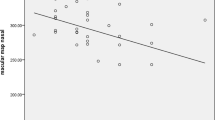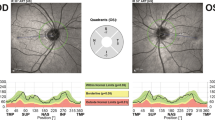Abstract
Foveal structure that is specified by the thickness, depth and the overall shape of the fovea is a promising tool to qualify and quantify retinal pathology in Parkinson’s disease. To determine the model variable that is best suited for discriminating Parkinson’s disease eyes from those of healthy controls and to assess correlations between impaired contrast sensitivity and foveal shape we characterized the fovea in 48 Parkinson’s disease patients and 45 control subjects by optical coherence tomography (OCT). The model quantifies structural changes in the fovea of Parkinson’s disease patients that are correlated with a decline in contrast sensitivity. Retinal foveal remodeling may serve as a parameter for vision deficits in Parkinson’s disease. Whether foveal remodeling reflects dopaminergic driven pathology or rather both dopaminergic and non-dopaminergic pathology has to be investigated in longitudinal studies.




Similar content being viewed by others
References
Adam CR, Shrier E, Ding Y et al (2013) Correlation of inner retinal thickness evaluated by spectral-domain optical coherence tomography and contrast sensitivity in Parkinson disease. J Neuroophthalmol 33:137–142
Bhaskar PA, Vanchilingam S, Bhaskar EA et al (1986) Effect of L-dopa on visual evoked potential in patients with Parkinson’s disease. Neurology 36:1119–1121
Bodis-Wollner I (1972) Visual acuity and contrast sensitivity in patients with cerebral lesions. Science 178:769–771. https://doi.org/10.1126/science.178.4062.769
Bodis-Wollner I, Yahr MD (1978) Measurements of visual evoked potentials in Parkinson’s disease. Brain 101:661–671
Bodis-Wollner I, Yahr MD, Mylin L, Thornton J (1982) Dopaminergic deficiency and delayed visual evoked potentials in humans. Ann Neurol 11:478–483
Bodis-Wollner I, Marx MS, Mitra S et al (1987) Visual dysfunction in Parkinson’s disease. Loss in spatiotemporal contrast sensitivity. Brain 110(Pt 6):1675–1698
Bodis-Wollner I, Miri S, Glazman S (2013) Venturing into the no-man’s land of the retina in Parkinson’s disease. Mov Disord 29:15–22
Bodis-Wollner I, Kozlowski PB, Glazman S, Miri S (2014) Alpha-synuclein in the inner retina in Parkinson disease. Ann Neurol 75(6):964–966
Bulens C, Meerwaldt JD, Van der Wildt GJ, Van Deursen JB (1987) Effect of levodopa treatment on contrast sensitivity in Parkinson’s disease. Ann Neurol 22:365–369
Buttner T, Kuhn W, Muller T et al (1996) Chromatic and achromatic visual evoked potentials in Parkinson’s disease. Electroencephalogr Clin Neurophysiol 100:443–447
Chorostecki J, Seraji-Bozorgzad N, Shah A et al (2015) Characterization of retinal architecture in Parkinson’s disease. J Neurol Sci 355:44–48. https://doi.org/10.1016/j.jns.2015.05.007
Delalande I, Hache JC, Forzy G et al (1998) Do visual-evoked potentials and spatiotemporal contrast sensitivity help to distinguish idiopathic Parkinson’s disease and multiple system atrophy? Mov Disord 13:446–452
Ding Y, Spund B, Glazman S et al (2014) Application of an OCT data-based mathematical model of the foveal pit in Parkinson disease. J Neural Transm 121:1367–1376
Firsov ML, Astakhova LA (2016) The role of dopamine in controlling retinal photoreceptor function in vertebrates. Neurosci Behav Physiol 46:138–145. https://doi.org/10.1007/s11055-015-0210-9
Gibb WR, Lees AJ (1988) The relevance of the Lewy body to the pathogenesis of idiopathic Parkinson’s disease. J Neurol Neurosurg Psychiatry 51:745–752
Guo L, Normando EM, Shah PA et al (2018) Oculo-visual abnormalities in Parkinson’s disease: possible value as biomarkers. Mov Disord 33:1390–1406. https://doi.org/10.1002/mds.27454
Hajee ME, March WF, Lazzaro DR et al (2009) Inner retinal layer thinning in Parkinson disease. Arch Ophthalmol 127:737–741
Harnois C, Di Paolo T (1990) Decreased dopamine in the retinas of patients with Parkinson’s disease. Invest Ophthalmol Vis Sci 31:2473–2475
Hasbi A, O’Dowd BF, George SR (2011) Dopamine D1–D2 receptor heteromer signaling pathway in the brain: emerging physiological relevance. Mol Brain 4:26. https://doi.org/10.1186/1756-6606-4-26
Ikeda H, Head GM, Ellis CJ (1994) Electrophysiological signs of retinal dopamine deficiency in recently diagnosed Parkinson’s disease and a follow up study. Vis Res 34:2629–2638
Inzelberg R, Ramirez JA, Nisipeanu P, Ophir A (2004) Retinal nerve fiber layer thinning in Parkinson disease. Vis Res 44:2793–2797
Müller A-K, Blasberg C, Südmeyer M et al (2014) Photoreceptor layer thinning in parkinsonian syndromes. Mov Disord 29:1222–1223
Nieves-Moreno M, Martínez-de-la-Casa JM, Morales-Fernández L et al (2018) Impacts of age and sex on retinal layer thicknesses measured by spectral domain optical coherence tomography with Spectralis. PLoS ONE 13:1–9. https://doi.org/10.1371/journal.pone.0194169
Nightingale S, Mitchell KW, Howe JW (1986) Visual evoked cortical potentials and pattern electroretinograms in Parkinson’s disease and control subjects. J Neurol Neurosurg Psychiatry 49:1280–1287
Ridder A, Müller MLTM, Kotagal V et al (2017) Impaired contrast sensitivity is associated with more severe cognitive impairment in Parkinson disease. Parkinsonism Relat Disord 34:15–19
Schneider M, Müller H-P, Lauda F et al (2014) Retinal single-layer analysis in Parkinsonian syndromes: an optical coherence tomography study. J Neural Transm 121:41–47
Slotnick S, Ding Y, Glazman S et al (2015) A novel retinal biomarker for Parkinson’s disease: quantifying the foveal pit with optical coherence tomography. Mov Disord 30(12):1692–1695
Spund B, Ding Y, Liu T et al (2013) Remodeling of the fovea in Parkinson disease. J Neural Transm 120(5):745–753
Stanzione P, Bodis-Wollner I, Pierantozzi M et al (1999) A mixed D1 and D2 antagonist does not replay pattern electroretinogram alterations observed with a selective D2 antagonist in normal humans: relationship with Parkinson’s disease pattern electroretinogram alterations. Clin Neurophysiol 110:82–85
Tagliati M, Bodis-Wollner I, Yahr MD (1996) The pattern electroretinogram in Parkinson’s disease reveals lack of retinal spatial tuning. Electroencephalogr Clin Neurophysiol 100:1–11
Tan JMM, Wong ESP, Lim K-L (2009) Protein misfolding and aggregation in Parkinson’s disease. Antioxid Redox Signal 11:2119–2134. https://doi.org/10.1089/ars.2009.2490
Terry L, Cassels N, Lu K et al (2016) Using spectral domain optical coherence tomography : evaluation of inter-session repeatability and agreement between devices. PLoS ONE. https://doi.org/10.1371/journal.pone.0162001
Turcano P, Chen JJ, Bureau BL, Savica R (2018) Early ophthalmologic features of Parkinson’s disease: a review of preceding clinical and diagnostic markers. J Neurol. https://doi.org/10.1007/s00415-018-9051-0
Watson AB, Barlow HB, Robson JG (1983) What does the eye see best? Nature 302:419–422. https://doi.org/10.1038/302419a0
Young JB, Godara P, Williams V et al (2019) Assessing retinal structure in patients with Parkinson disease. J Neurol Neurophysiol. https://doi.org/10.4172/2155-9562.1000485
Acknowledgements
A. Markopoulou from NorthShore University Health System, Evanston IL, USA participated in the study. Due to methodological reasons only the measurements from Ulm University were used for the final evaluation of the data.
Funding
The research was supported by the Michael J. Fox Foundations for Parkinson’s Research.
Author information
Authors and Affiliations
Corresponding author
Ethics declarations
Conflict of interest
All authors have no conflicts of interest and no competing interests.
Ethics approval
All procedures performed were in accordance with the ethical standards of the institutional research committees of the University of Ulm (36/13), the Institutional Review Board (IRB) of NorthShore University HealthSystem (EH13-077) and the SUNY Downstate Medical Center Institutional Review Board (418805) and with the 1964 Helsinki declaration and its later amendments or comparable ethical standards. Written informed consent was obtained from each subject.
Consent to participate
All authors consented to participate.
Consent for publication
All authors consented for publication.
Additional information
Publisher's Note
Springer Nature remains neutral with regard to jurisdictional claims in published maps and institutional affiliations.
Rights and permissions
About this article
Cite this article
Pinkhardt, E.H., Ding, Y., Slotnick, S. et al. The intrinsically restructured fovea is correlated with contrast sensitivity loss in Parkinson’s disease. J Neural Transm 127, 1275–1283 (2020). https://doi.org/10.1007/s00702-020-02224-9
Received:
Accepted:
Published:
Issue Date:
DOI: https://doi.org/10.1007/s00702-020-02224-9




